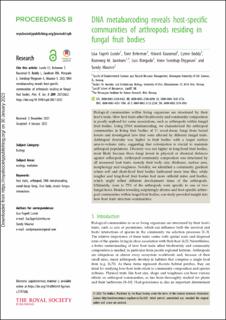| dc.contributor.author | Lunde, Lisa Fagerli | |
| dc.contributor.author | Birkemoe, Tone | |
| dc.contributor.author | Kauserud, Håvard | |
| dc.contributor.author | Boddy, Lynne | |
| dc.contributor.author | Jacobsen, Rannveig Margrete | |
| dc.contributor.author | Morgado, Luis | |
| dc.contributor.author | Sverdrup-Thygeson, Anne | |
| dc.contributor.author | Maurice, Sundy | |
| dc.date.accessioned | 2023-03-24T11:21:55Z | |
| dc.date.available | 2023-03-24T11:21:55Z | |
| dc.date.created | 2022-05-19T13:30:17Z | |
| dc.date.issued | 2022 | |
| dc.identifier.citation | Proceedings of the Royal Society of London. Biological Sciences. 2022, 289 (1968), . | en_US |
| dc.identifier.issn | 0962-8452 | |
| dc.identifier.uri | https://hdl.handle.net/11250/3060309 | |
| dc.description.abstract | Biological communities within living organisms are structured by their host’s traits. How host traits affect biodiversity and community composition is poorly explored for some associations, such as arthropods within fungal fruit bodies. Using DNA metabarcoding, we characterized the arthropod communities in living fruit bodies of 11 wood-decay fungi from boreal forests and investigated how they were affected by different fungal traits. Arthropod diversity was higher in fruit bodies with a larger surface area-to-volume ratio, suggesting that colonization is crucial to maintain arthropod populations. Diversity was not higher in long-lived fruit bodies, most likely because these fungi invest in physical or chemical defences against arthropods. Arthropod community composition was structured by all measured host traits, namely fruit body size, thickness, surface area, morphology and toughness. Notably, we identified a community gradient where soft and short-lived fruit bodies harboured more true flies, while tougher and long-lived fruit bodies had more oribatid mites and beetles, which might reflect different development times of the arthropods. Ultimately, close to 75% of the arthropods were specific to one or two fungal hosts. Besides revealing surprisingly diverse and host-specific arthropod communities within fungal fruit bodies, our study provided insight into how host traits structure communities. host traits, arthropod, DNA metabarcoding, wood-decay fungi, fruit body, insect–fungus interactions | |
| dc.language.iso | eng | en_US |
| dc.title | DNA metabarcoding reveals host-specific communities of arthropods residing in fungal fruit bodies | en_US |
| dc.title.alternative | DNA metabarcoding reveals host-specific communities of arthropods residing in fungal fruit bodies | en_US |
| dc.type | Peer reviewed | en_US |
| dc.type | Journal article | en_US |
| dc.description.version | publishedVersion | |
| dc.description.version | publishedVersion | |
| dc.subject.nsi | VDP::Zoologiske og botaniske fag: 480 | |
| dc.subject.nsi | VDP::Zoology and botany: 480 | |
| dc.subject.nsi | VDP::Zoologiske og botaniske fag: 480 | |
| dc.subject.nsi | VDP::Zoology and botany: 480 | |
| dc.subject.nsi | VDP::Zoologiske og botaniske fag: 480 | |
| dc.subject.nsi | VDP::Zoology and botany: 480 | |
| dc.source.pagenumber | 10 | en_US |
| dc.source.volume | 289 | en_US |
| dc.source.journal | Proceedings of the Royal Society of London. Biological Sciences | en_US |
| dc.source.issue | 1968 | en_US |
| dc.identifier.doi | 10.1098/rspb.2021.2622 | |
| dc.identifier.cristin | 2025640 | |
| dc.relation.project | Norges forskningsråd: 254746 | |
| cristin.ispublished | true | |
| cristin.fulltext | original | |
| cristin.fulltext | original | |
| cristin.qualitycode | 2 | |
